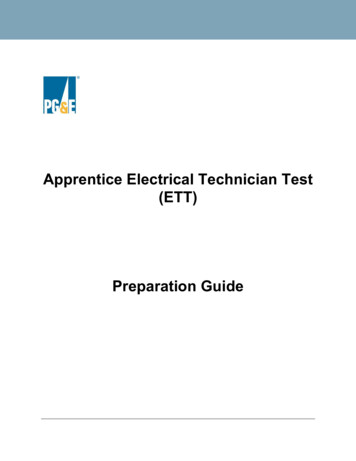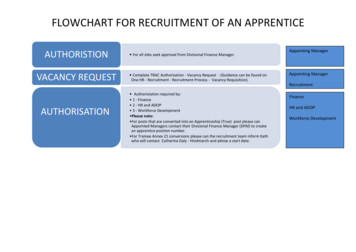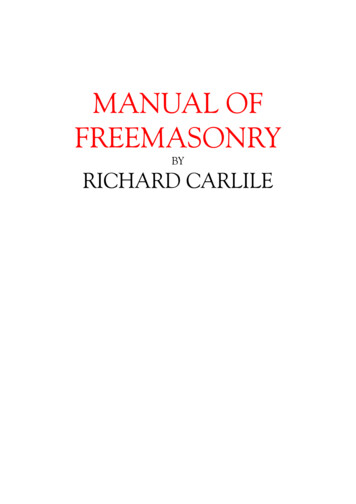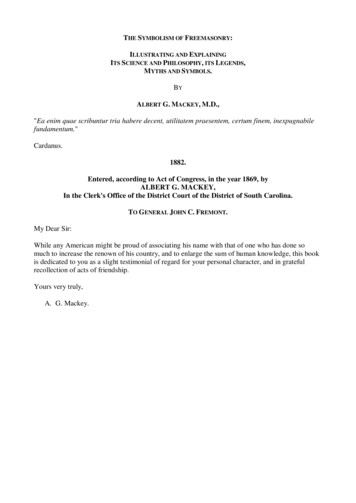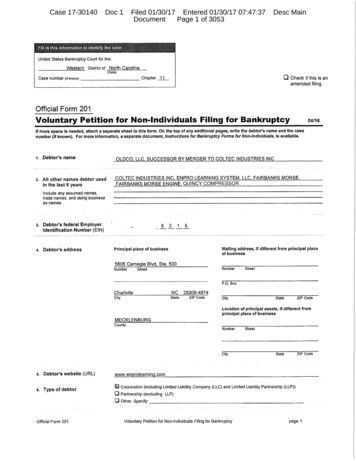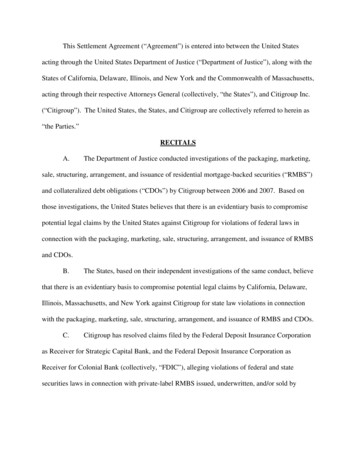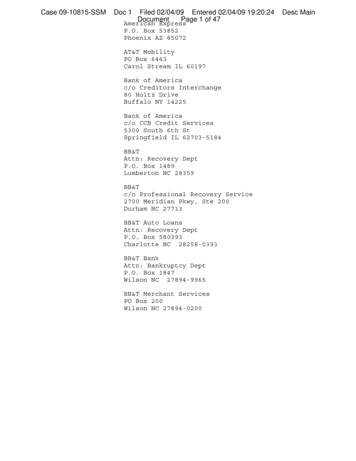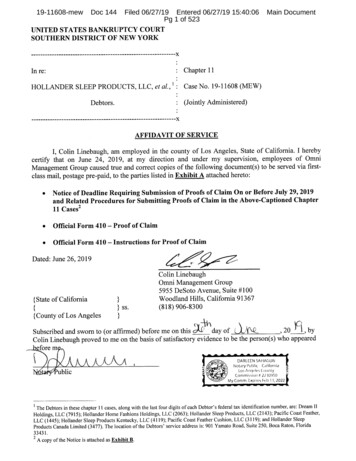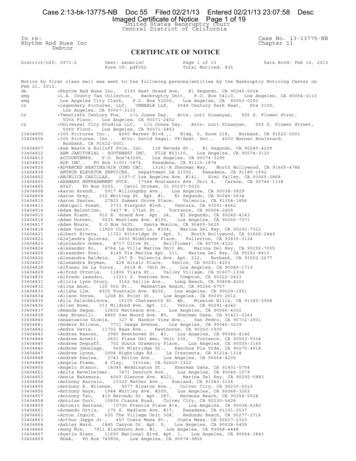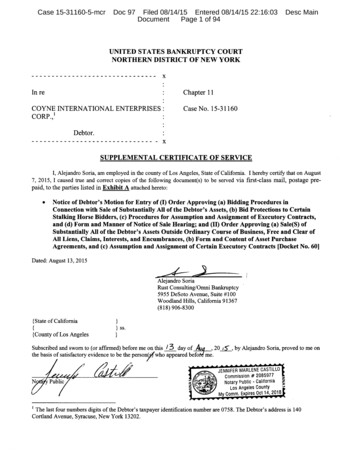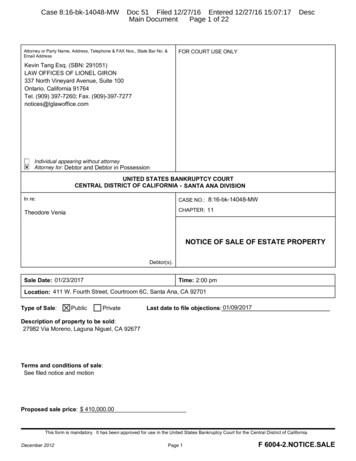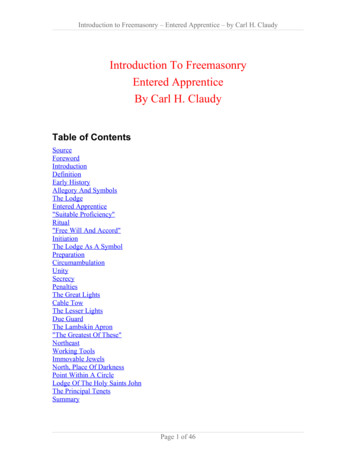
Transcription
Introduction to Freemasonry – Entered Apprentice – by Carl H. ClaudyIntroduction To FreemasonryEntered ApprenticeBy Carl H. ClaudyTable of ContentsSourceForewordIntroductionDefinitionEarly HistoryAllegory And SymbolsThe LodgeEntered Apprentice"Suitable Proficiency"Ritual"Free Will And Accord"InitiationThe Lodge As A tiesThe Great LightsCable TowThe Lesser LightsDue GuardThe Lambskin Apron"The Greatest Of These"NortheastWorking ToolsImmovable JewelsNorth, Place Of DarknessPoint Within A CircleLodge Of The Holy Saints JohnThe Principal TenetsSummaryPage 1 of 46
Introduction to Freemasonry – Entered Apprentice – by Carl H. ClaudySourceSeers seek for Wisdom's flowers in the mindAnd write of symbols Many a learned tome.(Grow roses still, though rooted in black loam.)The mystic searches earth till eyes go blindFor soul of roses, yet what use to findA spirit penned within a catacomb?Nay, all they learn is weightless as sea-foamThat drifts from wave to wave upon the wind.In rushes Cap and Bells. How very dollThe ways of students and the foolish books!He finds no secrets of Freemason's artIn mind nor rose nor tomb nor musty scroll;Where no wit is, where all loves are, he looksAnd reads their hidden meaning in his heart.Page 2 of 46
Introduction to Freemasonry – Entered Apprentice – by Carl H. ClaudyForewordFREEMASONRY'S greatest problems are lack of interest in its teachings and attendanceat communications. Many plans have been devised by Masonic leaders to stimulateinterest and increase attendance, but few such efforts are more than temporarily effective.The initial appeal of the Ancient Craft is as strong to-day as it has ever been.Freemasonry attracts as good men now as in the past. But in the absence of a concertedeffort to teach quickly what in a more leisurely age could be spread over many years, theInstitution often fails to hold the interest of the new brother against the many attractionsof modern life.Habits of lodge attendance and interest in the Fraternity should be created while the firstenthusiasm is high; moreover, every candidate has an inherent right to understand thereality of our rites, the meaning of our mysteries, the truth of our tenets, and thesignificance of our symbols.Many lodges attempt to intrigue the new brother with books. Some books areforbiddingly large; others are too learned; others assume that the reader has a knowledgewhich he does not possess. Some books are dull with many facts and no vision, whileothers are too specialized or confined to one viewpoint. These three volumes aredifferent. Written by a brother with long experience as a Masonic speaker and writer,they have a simple manner of presentation, a plain statement of facts, a spiritualinterpretation of Masonic teachings and visualize the vital reality behind the allegory andthe symbol.These books answer the simple elementary inquiries of the new brother to whom all theCraft is strange. They will make many an older Mason sit up in astonishment that what hethought obvious and uninteresting is so vividly alive.The author handles a heart-searching body of Masonic truth in a way so informative andso interesting, yet so touching and so tender, that the influence of these books whenpresented to and read by candidates must be vast and permanent.After years of activity in the Craft, culminating in service as Grand Master, I amconvinced that the most effective way to encourage interest and understanding is to beginat the beginning, that is, with the Entered Apprentice at the very threshold of his Masoniccareer. For this purpose I know of no other books which even attempt what these aredestined to accomplish, and I appreciate the honour of writing this brief Foreword at theinvitation of the publishers.For the brother old in the Craft who will read them, a revelation awaits. For the initiate,here is wisdom, strength and beauty. For all, the Ancient Craft is here set forth in anunforgettable trilogy of books which not only tell the facts but forget not the vision;which not only describe the form but also reveal the spirit of Freemasonry.The author is to be commended for the undertaking and complimented on theachievement.Howard R. Cruse, P.G.M. New Jersey August 17, 1931.Page 3 of 46
Introduction to Freemasonry – Entered Apprentice – by Carl H. ClaudyIntroductionAt your leisure hours, that you may improve in Masonic knowledge, you are to conversewith well-informed brethren, who will always be as ready to give, as you will be ready toreceive, instruction.These words from the Charge to an Entered Apprentice set forth the purpose of the threelittle books, of which this is the first: to give to the initiate, in his leisure hours, some"instruction" and information about the Fraternity not wholly imparted in the ceremoniesof initiation.These volumes are intended as simple introductions to the study of the Ancient Craft; theinterested Freemason will look further, for other and longer books; the uninterested willnot, perhaps, read all of these! Had completeness been the aim, these little books mighthave become forbiddingly large.No more has been attempted than to give some Masonic light on some of the history,jurisprudence, symbols, customs, and landmarks of the Order, by the rays of which anyinitiate may readily find his way down the path of Masonic learning which leads to thegate of truth.These books are far more gateways than guides to the foreign country of Freemasonry.However elemental they may be to the Masonic student, if their very simplicity leadsthose Entered Apprentices, Fellowcrafts, and newly raised Master Masons for whom theywere written to seek more Masonic light, their purpose will have been served and theirpreparation well worth the time and effort spent upon them.Page 4 of 46
Introduction to Freemasonry – Entered Apprentice – by Carl H. ClaudyDefinitionFreemasonry is a system of morality, veiled in allegory, and illustrated by symbols.This definition of the Ancient Craft means much more to the well-informed Freemasonthan to the initiate, to whom it can convey but little. Naturally he wants to know "WhyFreemasonry? Why is it veiled? Why illustrated with symbols?"Masons are "Free and Accepted" for reasons which are to be found in the early history ofFreemasonry.Page 5 of 46
Introduction to Freemasonry – Entered Apprentice – by Carl H. ClaudyEarly HistoryMany of Freemasonry's symbols and teachings go back to the very childhood of the race.Through these a direct relationship may be traced, in mind and heart and ideal, if not inwritten document, to such diverse ages and places as China four thousand years ago, thepriesthood of ancient Egypt, and the Jews of the Captivity. But for purposes ofunderstanding the genesis of the word "free" as coupled with "Mason," it will suffice tobegin with the Roman Collegia: orders or associations of men engaged in similarpursuits. Doubtless their formation was caused by the universal desire for fellowship andassociation, particularly strong in Rome, in which the individual was so largelysubmerged for the good of the empire, as well as by economic necessity, just as labourunions are formed to-day.These Collegia speedily became so prominent and powerful that Roman emperorsattempted to abolish the right of free association. In spite of edicts and persecutions, someof the Collegia continued to exist.The Colleges of Architects, however, were sanctioned for a time even after others wereforbidden. They were too valuable to the state to be abolished or made to work and meetin secret. They were not at this time called Freemasons, but they were free – and it is thefact and not the name which is here important. Without architects and builders Romecould not expand, so the Colleges of Architects were permitted to regulate their ownaffairs and work under their own constitutions, free of the restrictions which wereintended to destroy other Collegia.Then, as now, three were necessary to form a College (no Masonic lodge can meet withless than three); the College had a Magister or Master, and two Wardens, There werethree orders or degrees in the College which, to a large extent, used emblems which are apart of Freemasonry. Roman sarcophagi show carvings of a square, compasses, plumb,level, and sometimes columns.Of the ceremonies of the Collegia we know little or nothing. Of their work we knowmuch, and of their history, enough to trace their decline and fall. The Emperor Diocletianattempted to destroy the new religion, Christianity, which threatened so much whichseemed to the Romans to make Rome, Rome. Many members of the Colleges ofArchitects were Christians. Since these associations had taught and believed inbrotherhood, when there came a Carpenter who taught brotherhood because of a commonFather, the members of the Colleges of Architects took His doctrine, so strangelyfamiliar, for their own.Persecution, vengeance, cruelty followed; this is not the place to go into the story of thefour Masons and the apprentice who were tortured to death, only to become the fourcrowned martyrs and patron saints of later builders and the Masons of the Middle Ages.Suffice it that the Colleges of Architects were broken up and fled from Rome.Comes a gap which is not yet bridged. Between the downfall of Rome and the rise ofGothic architecture we know little of what happened to the builders' Collegia. It is herethat we come to the fascinating story of the Comacines. Some of the expelled buildersfound refuge on the island of Comacina in Lake Como and, through generation afterPage 6 of 46
Introduction to Freemasonry – Entered Apprentice – by Carl H. Claudygeneration, kept alive the traditions and secrets of their art until such time as the worldwas again ready for the Master Builders. All this is most interestingly set forth in severalbooks, best known of which is Leader Scott's Cathedral Builders; The Story of a GreatMasonic Guild. The author says that the Comacine Masters "were the link between theclassic Collegia and all other art and trade guilds of the Middle Ages. They wereFreemasons because they were builders of a privileged class, absolved from taxes andservitude, and free to travel about in times of feudal bondage."During the Middle Ages and the rise of Gothic architecture we find two distinct classes ofMasons; the Guild Masons, who, like the Guild carpenters or weavers or merchants, werelocal in character and strictly regulated by law, and the Freemasons, who travelled aboutfrom city to city as their services were needed to design and erect those marvellouschurches and cathedrals which stand to-day inimitable in beauty. It may not be affirmedas a proved fact that the Freemasons of the Middle Ages were the direct descendantsthrough the Comacine Masters of the Colleges of Architects of Rome, but there is toomuch evidence of a similar structure, ideal, and purpose, and too many similarities ofsymbol, tool, and custom, to dismiss the idea merely because we have no written recordcovering the period between the expulsion from Rome and the beginning of thecathedral-building age.However this may be, the operative builders and designers of the cathedrals of Europewere an older Order than the Guild Masons; it is from these Freemasons – free of theGuild and free of the local laws – that the Freemasonry of to-day has come. Incidentally,it may be noted that the historian Findel finds that the name Freemason appears as earlyas 1212, and the name occurs in 1375 in the history of the Company of Masons of theCity of London.The history of the Freemasons through the cathedral-building ages up to the Reformationand the gradual decline of the building art needs volumes where here are but pages. But itmust be emphasized that the Freemasons were far more than architects and builders; theywere artists, the leaders, the teachers, the mathematicians and the poets of their time. Intheir lodges Speculative Masonry grew side by side with their operative art. They werejealous of their Order and strict in their acceptance of Apprentices; strict in admittingApprentices to be Fellows of the Craft, requiring seven years of labour of an Apprenticebefore he might make his "Master's Piece" to submit to the Master and Wardens of hislodge, when, happy, he might become a Fellow and receive "the Mason Word."In an age when learning was difficult to get and association with the educated hardly tobe had outside of the church, it was but natural that thoughtful and scholarly men shoulddesire membership among the Freemasons. Such men, however, would not want topractice operative masonry, or serve a seven years' apprenticeship. Therefore a place wasmade for them by taking them in as accepted Masons; that is, accepted as membershaving something to offer and desiring to receive something from the lodge, butdistinguished from the operative Freemasons by the title accepted.It is not possible to say when this practice began. The Regius Poem, [i] the oldestdocument of Freemasonry (1390), speaks of Prince Edward (Tenth Century) as:Of speculatyfe he was a master.Page 7 of 46
Introduction to Freemasonry – Entered Apprentice – by Carl H. ClaudyDesiring to become architects and builders, ecclesiasts joined the order. Lovers of libertywere naturally attracted to a fellowship in which members enjoyed unusual freedom.Through the years, particularly those which saw the decline of great building and thecoming of the Reformation, more and more became the Accepted Masons and less andless the operative building Freemasons. Of forty-nine names on the roll of the Lodge ofAberdeen in the year 1670, thirty-nine were those of Accepted Masons.Hence our title – Free and Accepted Masons, abbreviated F. & A.M. There are variationsin certain jurisdictions,[ii] such as F. and A. M. (Free and Accepted Masons), A.F. &A.M. (Ancient Free and Accepted Masons), etc., the origin of which the student may findin the history of Freemasonry of the Grand Lod
These books answer the simple elementary inquiries of the new brother to whom all the Craft is strange. They will make many an older Mason sit up in astonishment that what he thought obvious and uninteresting is so vividly alive. The author handles a heart-searching body of Masonic truth in a
